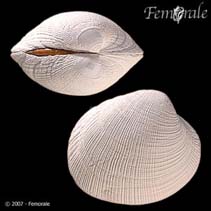Leukoma staminea (Conrad, 1837)
Pacific littleneck| Native range | All suitable habitat | Point map | Year 2050 |

|
| This map was computer-generated and has not yet been reviewed. |
| Leukoma staminea AquaMaps Data sources: GBIF OBIS |
Classification / Names ชื่อสามัญ | ชื่อพ้อง | CoL | ITIS | WoRMS
Bivalvia | Venerida | Veneridae
Environment: milieu / climate zone / ระดับความลึก / distribution range นิเวศวิทยา
; ระดับความลึก 0 - 46 m (อ้างอิง 95344). Boreal, preferred 8°C (อ้างอิง 107945); 60°N - 22°N, 166°E - 109°W
Distribution ประเทศต่างๆ | พื้นที่จำแนกตาม FAO | ระบบนิเวศหลายระบบ | การปรากฏขึ้น,การเกิดขึ้น,พบ | การแนะนำ
Pacific Ocean: West to east Bering Sea, Aleutian to Baja California.
Length at first maturity / ขนาด / Weight / Age
วัยเจริญพันธุ์: Lm ?, range 2 - 3.5 cm Max length : 7.5 cm SHL เพศผู้/กระเทย; (อ้างอิง 95344); common length : 6.4 cm SHL เพศผู้/กระเทย; (อ้างอิง 78182); อายุสูงสุดที่ได้รายงาน: 16 ปี (อ้างอิง 104675)
Life cycle and mating behavior วัยเจริญพันธุ์ | การสืบพันธุ์ | การวางไข่ | Eggs | ความดกของไข่ | Larvae
Main reference
อ้างอิง | ผู้ประสานงาน | ผู้ร่วมมือ
Shaw, W.N. 1986 Species Profiles: Life Histories and Environmental Requirments of Coastal Fishes and Invertebrates (Pacific Southwest). Biological Report 82 (11.46) TR EL-82-4. (อ้างอิง 78182)
IUCN Red List Status
(อ้างอิง 130435: Version 2025-1)
CITES status (อ้างอิง 108899)
CMS (อ้างอิง 116361)
Threat to humans
Human uses
การประมง: การค้า
FAO - การเพาะเลี้ยงสัตว์น้ำ: production; การประมง: landings | FishSource | ทะเลรอบๆเรา
เครื่องมือ
ข้อมูลเพิ่มเติม
Max. ages / sizes
Length-weight rel.
Length-length rel.
Length-frequencies
Mass conversion
อุดมสมบรูณ์
แหล่งที่มาจากอินเตอร์เน็ต
BHL | BOLD Systems | CISTI | DiscoverLife | FAO(การประมง: ; publication : search) | Fishipedia | GenBank (genome, nucleotide) | GloBI | Gomexsi | Google Books | Google Scholar | Google | PubMed | แผนภูมิชีวิตแบบต้นไม้ | Wikipedia (Go, ค้นหา) | บันทึกทางด้านสัตววิทยา



